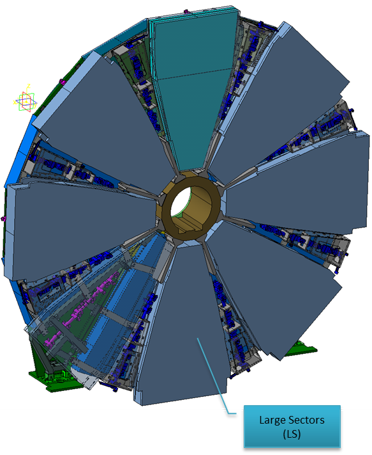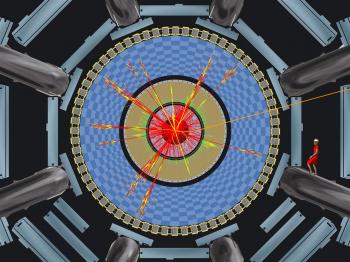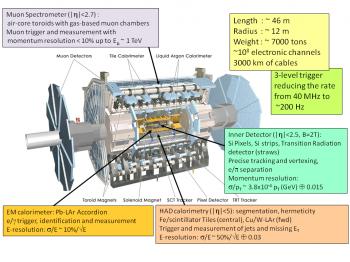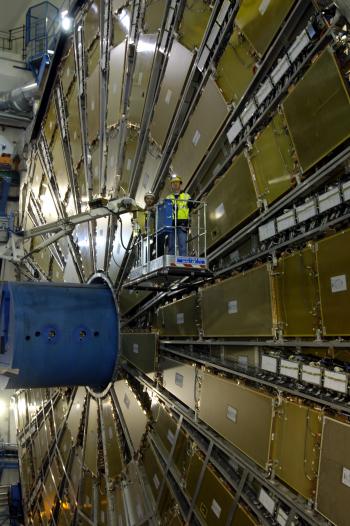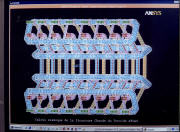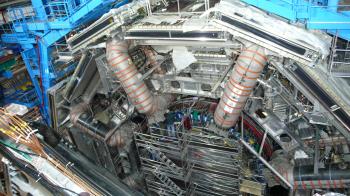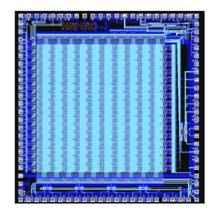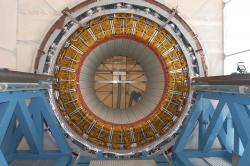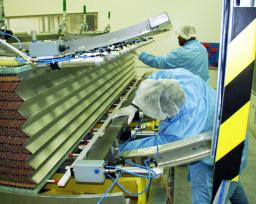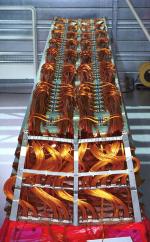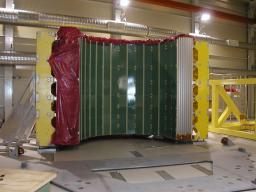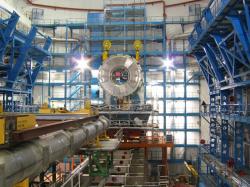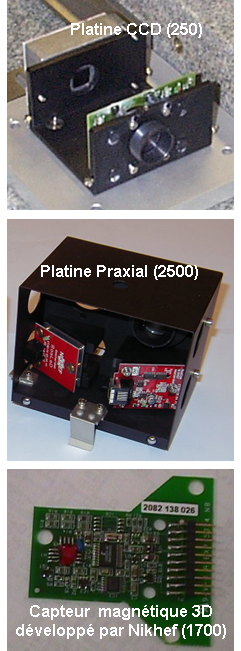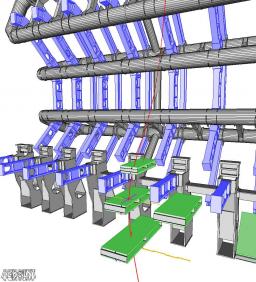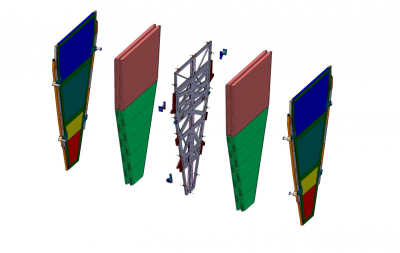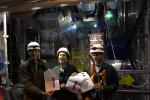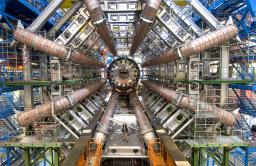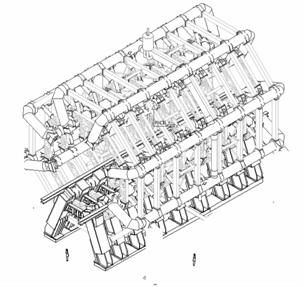Atlas is one of the general purpose detectors which started operation in 2008 at the the CERN proton collider, to study the Higgs boson.
Goals:
Atlas is one of the two general purpose detectors installed at the LHC which started operation in 2008. Atlas brings experimental physics into new territory. Discovering new processes and particles that change our understanding of energy and matter would be most exciting. Atlas will learn about the basic forces that have shaped our universe since the beginning of time and that will determine its fate. Fundamental questions arrise: Why do fundamental particles have such different masses ? How do particles acquire their mass ? To explain these mysteries, theories predict a new particle, the Higgs boson whose field could give mass to all the other particles. The particle with a mass of about 125 GeV the discovery of which has been announced in 2012 has all the properties of the Higgs boson, or at least one of the Higgs bosons, as several variants of the Standard Model predict the existence of several such particles. The existence of new particles is also conjectured in models beyond the Standard Model, one of which is Super Symmetry; it postulates new particles related to the known particles where a matter particle (fermion) has a force carrier (boson) as partner, and vice versa. Possible implications are extra dimensions in space-time and mini black holes.
At the very beginning of the universe, equal amounts of matter and antimatter existed. If matter and antimatter were exact miror images of each other, they would have completely annihilated to leave only energy. But why was some of the matter left over to create galaxies, the solar system with our planet, and... us ? Atlas will explore the tiny diffeence that exists between matter and antimatter. LHC will recreate the conditions of the universe just after the Big Bang to understand why the universe is like it is today. Atlas will investigate why the matter of the universe is dominated by an unknown type called dark matter. If constituants of dark matter are new particles, Atlas should discover them and elucidate the mystery of dark matter.
Themes/Associated programs
- Elementary constituants of matter / Physics at LHC
- Magnets and accelerators / superconducting magnets
- Innovation in detection systems / Detecteurs development
- Signal processing and online systems

Partial view of Atlas, in mid-2007
Context
Since 2010, Atlas has observed dramatic head-on collisions of pairs of protons with a total energy of 7 TeV until 2011, and of 8 TeV in 2012. After a break in 2013-2014 to improve the performances of the magnet system of the accelerator, the collision energy has been increased up to 13 TeV in 2015. The protons are accelerated to these record high energies by the Large Hadron Collider (LHC) - an underground accelerator ring 27 km in circumference located at the CERN laboratory near Geneva.
Atlas was approved in 1995, and is one of the large general purpose experiments operating at the LHC.
IRFU also contributes to the second large experiment with similar goals: CMS
Contributions by IRFU
Electromagnetic Calorimeter
Liquid argon and lead absorber
Fabrication and assembly of 40 % of the barrel calorimeter (mecanical engineering, cryogeny, control)
Electronics (analog signal summation and filters); radiation hard electronics (DMILL process)
Upgrade phase 1 (2018): Design and construction of part of the electronic cards which produce the improved level 1 trigger decision for the electromagnetic calorimeter (electron,photons)
Muon spectrometer:
Alignment System for muon chambers with optical devices (≈ 30 microns)
Measurement and mapping of the magnetic fields in Atlas
Upgrade phase 1 (2018): Construction with the MicroMegas technology, pioneered at Saclay) of 25% of the muon chambers of the new smal wheels in the forward part of the muon spectrometer. Strong participation in the global integration of the NSW and of its alignment.
Atlas Barrel Toroid
Software
Detailed detector description
Computation of the magnetic field map
Track reconstruction in the muon spectrometer
Detector end event display
Standard Model Physics
Study of the final states with a pair of gauge bosons (ZZ, WZ, WW, Wgamma, Zgamma).
Precision measurements of the top quark mass and the W boson
Search for the Higgs boson in the ZZ decay channel
Search for new particles: Heavy resonnances, dark matter candidate particles, top partners
Upgrade phase 2 (Horizon 2024: HL-LHC):
Research and development on thin fine grain pixels sensors in the HV/HR CMOS technology. Pixels detectors built with this technology may allow for rather low cost high resolution pixel detectors for the future ATLAS inner detector, while being suffiently radiation hard for the high luminosity expected at the HL-LHC starting in 2014.
Participation to the design and construction of the new Front End electronic boards for the liquid argon calorimeter.
Study of the possibility to use fast micromegas chambers (with very short drift distance and a cerenkov crystal and a photocathode to produce several photoelectrons per muon) to equip a muon tagger located at very large pseudorapidities beyond the acceptance of the muon spectrometer.
Contacts:
Means of investigation
Research topics:
The "Standard Model": our vision of the elementary constituents and their interactions as described by the relativistic quantum field theory and by very deep principles of symmetry.
Since this model is not capable of encompassing all known physical phenomena (gravitation, matter and dark energy, matter-antimatter asymmetry), our aim is to seek experimental clues that can put us on the path of a more complete theory.
Principles of the experiment:
Atlas observes spectacular collisions of protons with a total energy of 13 TeV in the centre of mass (14 TeV from 2021). These protons are accelerated by the LHC, an underground accelerating ring of 27 km in circumference. The LHC tunnel is fully equipped with superconducting magnets that direct and focus protons on circular trajectories. The successive layers of the Atlas detector are used to determine the trajectories of charged particles and to measure the energy of most charged and neutral particles. The curvature of trajectories in the magnetic field makes it possible to determine their momentum and their electrical charge. Of the thousand million collisions produced per second, only a few possess particular characteristics that can lead to discoveries. The trigger system selects these events to avoid recording an enormous - and unnecessary - amount of information.
The analysis of particles from proton frontal collisions has already revealed the existence of a new particle, the Higgs boson, which is essential for the validation of the "Standard Model". Current and future data taking may help to shed some light on unknown processes at the core of matter.
Technical description
All magnets are superconducting. Electromagnetic and hadronic calorimeters complete this apparatus. A central solenoid magnet provides a field of 2 Teslas for precise trajectography with the inner detector.
Specificities
The Atlas detector, measuring 46 m long and 25 m high, is the largest and, together with the CMS detector, the most complex detector ever built for a particle physics experiment. It is also remarkable for its magnetic configuration. The large size of the magnetic volume (without iron, unlike the case of a conventional device) allows an accurate measurement of high energy muons.
Basic differences between Atlas and CMS:
The magnetic fields used for the outer muon spectrometer are very different:
Atlas: the eight coils, enclosed in a cryostat, are assembled in a large structure, in which a very large electric current creates a toroidal magnetic field around the axis of the beam and not along the axis of the cylinder as in CMS. The Atlas muon spectrometer is a stand-alone system that requires little monitoring after start-up.
CMS: Most of the experiment is a cylinder in which a very powerful solenoidal magnetic field acts along the proton beam. The return field in the iron yoke is also used to complete the measurement of the muon momentum in the inner detector.
Electromagnetic calorimeters that measure the energies and positions of photons and electrons use very different techniques: A lead-liquid argon sandwich for ATLAS, which favors radiation resistance and accuracy of position measurement, scintillating crystals for CMS which favors the resolution of the energy measurement, in particular for low values.
Collaborations internationales:
ATLAS is an international collaboration gathering 1927 physicists and about 1000 students from 210 institutes in 39 countries.
Historique et principaux jalons
- 1995 :
- TDR et approbation d'Atlas et CMS
- ASCOT et EAGLE fusionnent pour travailler sur Atlas.
- 1998 : Début génie civil
- 2000 :
- Fabrication et test bobine prototype (longueur 1/3) du toroïde.
- Choix du type de capteur pour l'alignement.
- 2001 :
- Construction du premier module du calorimètre électromagnétique (argon liquide) au Dapnia.
- Fin de développement des cartes électroniques pour le déclenchement du calorimètre.
- 2001-2003 : Tests en faisceau de modules du calorimètre, du prototype de système d'alignement muons.
- 2004 :
- Première bobine de l'aimant toroïdal.
- Fin assemblage calorimètre central.
- 2006 :
- Calorimètre opérationnel.
- Achèvement et test de l'aimant toroïdal.
Etat de l'expérience
- 2007 et suivantes : Commissionning Atlas
- 2008 : Fermeture de la caverne, démarrage du LHC, premières données. Aout : fonctionnement du toroïde (partie centrale et bouchons) à sa puissance nominale. Etalonnage des détecteurs par la détection de muons atmosphériques
- 10 septembre 2008 : Premiers faisceaux au LHC
- 29 mars 2010 : Premières collisions à 7 TeV d'énergie dans le centre de masse proton-proton.
- 4 juillet 2012 : Annonce de la découverte d'une particule de masse 125 GeV ayant les caractéristiques attendues du boson de Higgs.
- 2013-2014 : Arret de la machine LHC et remise à niveau du détecteur (réparation de certains sous-détecteurs défectueux), l'ajout d'un detecteur de vertex à pixels autour du tube faisceau, l'amélioration de la couverte en muon avec l'ajout de certaines chambres à fils et l'amélioration du système de déclenchement.
- Mai 2015: Premières collisions à 13 TeV.
- 210 laboratories and universities
- 39 countries in the Aylas collaboration
- 1927 physicists
- 800 ingineers
- about 1000 students
- 46m long
- 25m high
- Eight supraconducting coils 25m long and 5m wide.
- Magnetic field delivered by the barrel solenoïd magnet: 2T
Publications
- The Atlas Experiment at the CERN Large Hadron Collider. By ATLAS Collaboration. Journal of Instrumentation 3, S08003, 2008.
- ATLAS computing technical proposal. By ATLAS Collaboration (A. Airapetian et al.). CERN-LHCC-96-43, Dec 1996.
- ATLAS: Technical proposal for a general-purpose p p experiment at the Large Hadron Collider at CERN. By ATLAS Collaboration (W.W. Armstrong et al.). CERN-LHCC-94-43, Dec 1994.
- Lien vers les publications de la collaboration Atlas.
PhDs
Past thesis
- Nicolas Kerschen: Etude des performances de la calorimétrie de l'expérience ATLAS dans un faisceau de test, et application à la recherche de nouvelles particules auprès du LHC
- Clément Helsens: Recherche de résonance de grande masse dans le canal dimuon à l'aide du spectromètre à muon de l'expérience ATLAS auprès du LHC
- Oldrich Kepka: “QCD and Diffraction in the ATLAS Experiment at the LHC”
- Antoine Marzin : « Méthode de mesure de la masse du quark top avec le détecteur ATLAS au LHC. Etude du fonctionnement du système de déclenchement de niveau 1 du calorimètre électromagnétique.»
- Bruno Lenzi: ” Search for the Higgs boson decaying to four leptons in the ATLAS detector at LHC and studies of muon isolation and energy loss"
- Eve Le Ménédeu : « Étude des performances du spectromètre à muons du détecteur Atlas au LHC, des collisions aux cosmiques. Mesure de la section efficace de production des dibosons WZ.»
- Van Nguyen: «Mesure de la distribution de l'impulsion transverse des bosons W au LHC avec le détecteur ATLAS.»
- Yu Jie (cotutelle Nanjing) : «Mesure de la section efficace de production de paires de quarks, top-antitop à l'aide des premières données du détecteur ATLAS auprès du LHC.»
- Chao Xu (cotutelle USTC): «Mesure du rapport des sections efficaces des bosons W et Z produits en association avec un jet dans les collisions proton-proton a √ s=7 TeV avec le détecteur ATLAS.»
- Cécile Deterre (D0/ATLAS): « Étude dans les états finals di-leptoniques de différentes propriétés des paires top-antitop avec les détecteurs D0 et ATLAS. »
- Nicolas Morange: «Recherche du boson de Higgs en quatre leptons au LHC: étude des événements avec bosons Z et jets b dans l'expérience ATLAS. Étude des performances du système de déclenchement du calorimètre électromagnétique.»
- Meng Xiao: «Search for the Higgs boson decaying to four leptons in the ATLAS detector at LHC leading to the observation of a new particle compatible with the Higgs Boson.»
- Lea Gauthier: «Etudes dans le canal avec deux leptons de même signe de la physique du top au-delà du Modèle Standard.»
- Eleni Mountricha (cotutelle Athènes): «Search for the Standard Model Higgs boson with the ATLAS experiment at the LHC leading to the observation of a new particle compatible with the Higgs boson.»
- Joany Manjares-Ramos: «Mesure des dibosons WZ avec le détecteur ATLAS auprès du LHC et étude des performances des Micromegas résistifs en vue de leur application auprès du HL-LHC.»
- Homero Martinez: «Mesure de la section efficace différentielle en impulsion transverse du boson Z dans le canal électron - positron avec le détecteur ATLAS au LHC.»
- Rafal Staszewski (Cotutelle Cracovie): «Study of Diffraction with the ATLAS detector at the LHC.»
- Maciej Trzebinski (cotutelle Cracovie): «Etude de la diffraction dans l'expérience ATLAS au LHC.»
- Hervé Grabas: «Développement d’un système de mesure du temps de vol picoseconde dans l’expérience ATLAS.»
- Fabrice Balli: « Calibration de l'échelle d'énergie des jets et mesure de la masse du quark top dans le canal semi-leptonique dans l'expérience ATLAS.» 2014
- Sofia Protopapadaki: « ZZ diboson measurements with the ATLAS detector at the LHC and study of the toroidal magnetic field sensors.» 2014
- Mateusz Dyndal: «Two-Photon Interactions in Proton-Proton Collisions with the ATLAS Experiment at the LHC » 2015
- Alessandro Calandri: «Propriétés du Boson de Higgs se désintégrant en 4 leptons au LHC dans l’expérience ATLAS: masse, limite sur la contribution à haute masse et sur la largeur.» 2015
- Remie Hanna: «Contributions à une première mesure de la masse du boson W dans le canal électronique auprès du détecteur ATLAS.» 2015
- Romain Kukla: «Le quark top comme sonde pour la recherche de nouvelle physique au LHC, avec le détecteur ATLAS.» 2015
- &Matthias Saimpert: «Mesure de la section efficace de production de paires de photons isolés dans l'expérience ATLAS au LHC et étude des couplages à quatre photons.» 2016
- Oleh Kivernyk: « Etude de la production de bosons W a grande masse transverse. Mesure des parametres de la resonance et sensibilite a la physique non-standard.» 2016
- Maria Hoffmann: « Recherche d’un boson de Higgs additionnel de plus haute masse via sa désintégration en une paire de bosons de jauge Z avec le détecteur ATLAS au LHC.» 2016
Ongoing thesis
- Marta Maria Perego
- Eloi Le Quilleuc
- Arthur Lesage
- Denys Denysiuk
- Laura Pacecco
- Shuyang Hu (cotutelle)
- Tairan Xu (cotutelle)
- Thibault Chevalerias
Patents
The integrated circuit HAMAC, developed with the LAL Orsay for the calorimeter readout, had many descendants, some of which are the subject of patents.
GOAL:
The electromagnetic calorimeter detects and identifies electrons and photons, and measures their energy.
Context:
The technology which is used offers a fast response to detected particles and an excellent stability.
Contribution by IRFU
Responsabilities:
-Bruno Mansoulié: co-convenor of the working group in the conceptual phase; Task Leader for the construction of the barrel electromagnetic calorimeter (1997-2003).
Calorimeter Description
In general, a calorimeter is made of metal sheets (absorbers) and a detection medium. Whenever a particle meets the absorber, it interacts with the material and produces a shower of secondary particles which are detected in the detection medium. In the electromagnetic calorimeter the absorbers are made of lead and the detection medium is liquid agon. The space filled with liquid argon is under an intense electric field (2000 V over 2 mm). Particles in the shower produce ionization electrons which drift through the liquid argon driven by the electric field. The signal derived from this electron current is amplified, shaped, digitized and recorded.
The calorimeter is embedded in a cryostat filled with liquid argon at 88 °K.
Features
- Fine granularity, both lateral and longitudinal to the shower direction.
Topics and programs
Collaboration
The conception, development, construction and testing of the barrel electromagnetic calorimeter was a collaborative effort by the following institutes:
Main phases of the project
- Aachen 1990 : R&D proposal to study a liquid argon calorimeter with an "accordion" geometry at the LHC ;
- July 1993 : ATLAS chooses this technology for the electromagnetic calorimeter; IRFU(Dapnia) starts involvement;
- December 1996 : Technical Design Report. Layout decided; sharing of responsibilities agreed upon;
- June 2000 : Start construction of first module at Saclay;
- May 2003 : Last module received at CERN;
- December 2003: Barrel calorimeter inserted into cryostat;
- June-July 2004 : Final validation tests in liquid argon;
- October 2004 : Lowering of barrel calorimeter + cryostat into the underground Atlas cavern;
- 2006 : Cooldown and filling with liquid argon;
- end 2006: Calorimeter is operational and records cosmic rays;
- December 2007: End of commissioning.
-2013-2019: Phase 1 upgrade; replacement of the analog trigger cards by digital ones to allow for a better spatial granularity and a more performant triggering scheme.
- 2017-2014: Phase 2 upgrade; replacement of all front end electronics (except phase 1 trigger cards).
Fact sheet
The barrel calorimeter is made of two 60 ton "wheels" of 16 modules each (R int = 3m, R ext = 4m, Length = 3.2m). Each module is an assembly of 64 absorbers and as many electrodes.
110 000 readout channels; radiation hard electronics (40 MHz, 17 bits)
Performance
The calorimeter performance was measured in particle beam tests with the actual modules:
Contact
Scientific output
-publications
Energy linearity and resolution of the ATLAS electromagnetic barrel
calorimeter in an electron test-beam.
By ATLAS Electromagnetic Barrel Calorimeter Collaboration (M. Aharrouche et
al.). Aug 2006. 48pp.
Published in Nucl.Instrum.Meth.A568:601-623,2006.
e-Print: physics/0608012
Construction, assembly and tests of the ATLAS electromagnetic barrel
calorimeter.
By ATLAS Electromagnetic Barrel Liquid Argon Calorimeter Group (B. Aubert et
al.). CERN-PH-EP-2005-034, Jul 2005. 77pp.
Published in Nucl.Instrum.Meth.A558:388-418,2006.
Performance of the ATLAS electromagnetic calorimeter end-cap module 0.
By The ATLAS Electromagnetic Liquid Argon Calorimeter Group (B. Aubert et al.).
CERN-EP-2002-104, Nov 2002. 31pp.
Published in Nucl.Instrum.Meth.A500:178-201,2003.
Performance of the ATLAS electromagnetic calorimeter barrel module 0.
By ATLAS Electromagnetic Liquid Argon Calorimeter Group (B. Aubert et al.).
CERN-EP-2002-087, Nov 2002. 48pp.
Published in Nucl.Instrum.Meth.A500:202-231,2003,
Erratum-ibid.A517:399-402,2004.
Mechanical aspects of the ATLAS barrel electro-magnetic calorimeter.
B. Mansoulie (DAPNIA, Saclay) . Jun 1996.
Prepared for 6th International Conference on Calorimetry in High-energy Physics
(ICCHEP 96), Rome, Italy, 8-14 Jun 1996.
Published in *Frascati 1996, Calorimetry in high energy physics* 407-416
Hadron energy reconstruction for the ATLAS calorimetry in the framework of
the nonparametrical method.
By ATLAS Collaboration (S. Akhmadalev et al.). Apr 2001. 33pp.
Published in Nucl.Instrum.Meth.A480:508-523,2002.
Measurement of the photon direction in the ATLAS electromagnetic calorimeter
with the help of neural networks.
By ATLAS Liquid Argon Collaboration (B. Mansoulie et al.). Jun 1999.
Prepared for 8th International Conference on Calorimetry in High-Energy Physics
(CALOR 99), Lisbon, Portugal, 13-19 Jun 1999.
Published in *Lisbon 1999, Calorimetry in high energy physics* 736-743
Results from a new combined test of an electromagnetic liquid argon
calorimeter with a hadronic scintillating-tile calorimeter.
By ATLAS Collaboration (S. Akhmadalev et al.). 2000.
Published in Nucl.Instrum.Meth.A449:461-477,2000.
ATLAS calorimeter performance Technical Design Report.
By ATLAS Collaboration (A. Airapetian et al.). CERN-LHCC-96-40, Dec 1996. 189pp.
Test beam results of a stereo preshower integrated in the liquid argon
accordion calorimeter.
By RD3 Collaboration (R.A. Davis et al.). CERN-PPE-97-133, Aug 1997. 35pp.
Published in Nucl.Instrum.Meth.A411:313-329,1998.
Results from a combined test of an electromagnetic liquid argon calorimeter
with a hadronic scintillating tile calorimeter.
By ATLAS Collaboration (Z. Ajaltouni et al.). CERN-PPE-96-178, Nov 1996. 28pp.
Published in Nucl.Instrum.Meth.A387:333-351,1997.
Performance of a large scale prototype of the ATLAS accordion
electromagnetic calorimeter.
By RD3 Collaboration (D.M. Gingrich et al.). CERN-PPE-95-035, CERN-PPE-95-35,
Mar 1995. 39pp.
Published in Nucl.Instrum.Meth.A364:290-306,1995.
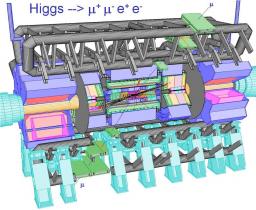
Simulated "Higgs" event in ATLAS.
The superconducting toroid coils are in grey, and the muon chambers in green.
Muons can penetrate through the calorimeters and reach the outermost part of ATLAS, known as the muon spectrometer. This spectrometer surrounds the calorimeters and measures the trajectories of muons to determine their direction, their electric charge and their momentum. This happens inside a volume of magnetic field produced by superconducting toroïd magnets. The detection elements (the muon chambers) are made of thousands of metal tubes equiped with a central wire and filled with gas. As a muon passes through these tubes, it leaves a trail of electrically charged ions and electrons which drift to the sides and center of the tube. By measuring the time it takes for these charges to drift from the starting point, it is possible to determine the position of the muon as it passes through.
Muons reach the spectrometer with little perturbation from their journey through the calorimeters and are an essential signature of new phenomena, in particular in the search for the Higgs boson or a heavy Z' boson. Three layers of more than 650 muon chambers are installed in the barrel muon spectrometer. In order to achieve the required transverse momentum relative resolution of 10% for a 1 TeV muon, the track curvature (sagitta) must be known with an accuracy of ≈ 60 microns. An optical alignment system is used to infer the positions of the chambers within 30 microns, as well as the chambers' deformation. The muon chambers are thus called MDT chambers (Monitored Drift Tubes), "monitored" referring to the optical alignment devices the chambers contain.
TOPICS/PROGRAMS
Innovation in detection systems/ Detector development
CONTEXT
The magnetic field configuration and in particular the muon spectrometer is a unique charateristic feature of ATLAS. The magnetic field is provided by four superconducting magnets: a solenoid surrounding the inner tracker and three air core toroids (one barrel and two endcaps), each made of 8 coils. The one of its kind barrel toroid generates a magnetic field in a very large volume. This volume is instrumented with 3 layers of muon chambers covering an area larger than several rugby fields. The IRFU group has taken charge of the alignment system of the barrel spectrometer, the field measurements in the toroids, and the muon reconstruction software.
CONTRIBUTIONS of IRFU
Contributions:
- Design, manufacturing, assembly, calibration, installation and commissioning of the barrel alignment system (several thousands of mechanical, optical and electronics componants)
- Software for providing alignment parameters and their monitoring
- Software for muon track reconstruction, detector + event display
- Magnetic field map: instrumentation inside toroids (measurements with Hall probes); calculation of the field, including contributions from magnetic material
Responsibilities:
Alignment system for the barrel muon spectrometer.
Global magnetic fied map for ATLAS
Muon reconstruction software
Scope of the projet:
- The ressources devoted to this project (Alignment and magnetic field in the barrel spectrometer) amount to an average of ≈100FTE over a period of 14 years, including 5 years of R&D.
COLLABORATION
NIKHEF (Amsterdam), CERN
INSTRUMENTATION
In order to achieve the required precision in the measurement of the muon track curvature (60 microns), the muon chambers are equiped, at strategic locations, with a grid of 5800 triplets of optical devices which continuously monitor the chamber positions and deformations. The required precision of the alignment system is 30 microns over distances larger than 10 meters. An optical line uses a beam of infrared light to align 3 chambers, each being equiped with one element of the triplet. The image of a back lighted chessboard mask, precisely positionned on the first chamber, is projected on a CMOS image sensor located on the third chamber through a lens located on the second chamber. The combination of the 5800 measurements makes it possible to determine the positions of all chambers at all times with the required precision.
The alignment system was successfully tested during the commissioning of the toroid magnet. The eight coils of the magnet were equiped with infrared cameras to form 128 optical lines with the chamber sensors. As a current of 21 kA was circulated, coil movements of 1-2 mm were recorded, as expected.
A precise magnetic field map, rapidly and repeatedly accessible by the reconstruction programs (e.g. "Muonboy"), is needed to measure the momentum of muons. The field is determined using 1800 sensors equiped with 3 Hall probes measuring the three components of the field. Placed close to the coils, these sensors provide the needed measurements to calculate the magnetic field everywhere in the spectrometer with a precision of 1mT. The sensors were inter-calibrated to correct for geometrical and temperature effects.
Contributions to the field comming from magnetic material in ATLAS, e.g. the iron hadron calorimeter and support structures, are taken into account through finite element calculations.
Features:
ATLAS must face new challenges.
This experiment is the largest and most complex detector ever built for a particle physics experiment. The total weight of ATLAS is 7000 tons, its size is 25m in diameter and 46m in length, and it features 100 million channels of electronics. The challenges are in mechanical engineering, industrial manufacturing of state of the art particle detectors and magnets, radiation hard electronics, sophisticated trigger electronics, high speed world wide data transmission, usage of very large data bases, complex software packages for data analysis.
Due to very high intensity proton beams, detectors as well as electronics must be designed to sustain considerable radiation. Also, because the LHC produces one billion collisions per second, the amount of data to be sorted, processed and stored reaches levels never achieved before.
The analysis of these data is performed in universities and laboratories round the world using the "computing grid". The grid's purpose is to make all the usable worldwide computing and data storage power available in one network of resources.
MAIN PHASES OF THE PROJECT
- 1994: Dapnia ATLAS group is formed
- 1997: Muon Spectrometer Technical Design Report
- 1998: ATLAS Memorandum of Understanding (sharing responsibilities and providing ressources); Setting up of the Review Committee for ATLAS at Dapnia
- 2000: Report to Dapnia SPP Physics Advisory Committee (CSTS)
- 2001-2003: Optimize spectrometer layout and design global alignment system
- 2003-2006: Manufacturing and calibration of alignment sensors on a test bench at Saclay; Assembly of the optical lines at CERN
- 2003-2004: Validation of alignment system in a CERN test beam
- 2005-2007: Installation and positioning of muon chambers at CERN; alignment system commissioning
- September 2005: Alignment system is used to monior toroïd mechanical release from its supports
- End 2006: 21 000 A current in barrel toroid: Alignment system measures toroid deformation with "field ON"; Magnetic field is measured with Hall probes; Cosmic rays are detected and analysed in muon spectrometer
- 2007-2008: Final commisioning (also with cosmic rays) of the alignment system, the magnetic field measurement and the software
- 2008-2009: Global test of magnet system, final comissioning of alignment and magnetic field measurement systems. Start taking data.
Important milestones:
Detection of cosmic rays: see details
Perspectives: Phase 1 upgrade of the muon spectrometer
SCIENTIFIC OUTPUT
Measurement of the muon reconstruction performance of the ATLAS detector using 2011 and 2012 LHC proton-proton collision data, ATLAS Collaboration, Eur.Phys.J. C74 (2014) 3130
The alignment system of the barrel part of the ATLAS muon spectrometer. J.C. Barriere et al. ATL-MUON-PUB-2008-007; http://cds.cern.ch/record/1081769/files/muon-pub-2008-007.pdf.
The control on the deformation of the ATLAS barrel toroid warm structure.
F. Bauer, A. Foussat, P.F. Giraud, C. Guyot, B. Levesy, P. Ponsot, P. Schune, Z.
Sun, P. Vedrine (DAPNIA, Saclay & CERN) . 2007. 4pp.
Prepared for 10th Pisa Meeting on Advanced Detectors: Frontier Detectors for
Frontier Physics, La Biodola, Elba, Italy, 21-27 May 2006.
Published in Nucl.Instrum.Meth.A572:145-148,2007.
Combined test beam results on the alignment of muon chambers and muon
reconstruction in the 2004 ATLAS H8 setup.
F. Bauer et al. 2007. 4pp.
Prepared for 10th Pisa Meeting on Advanced Detectors: Frontier Detectors for
Frontier Physics, La Biodola, Elba, Italy, 21-27 May 2006.
Published in Nucl.Instrum.Meth.A572:98-101,2007.
system.
J.C. Barriere et al. 2006. 4pp.
Prepared for International Workshop on Semiconductor Pixel Detectors for
Particles and Imaging, Bonn, Germany, 5-8 Sep 2005.
Published in Nucl.Instrum.Meth.A565:268-271,2006.
spectrometer.
J.C. Barriere et al. DAPNIA-04-508, Apr 2005. 5pp.
Prepared for 2004 IEEE Nuclear Science Symposium and Medical Imaging Conference
(NSS / MIC), Rome, Italy, 16-22 Oct 2004.
Status of the alignment sensor calibrations in the ATLAS muon experiment.
J.C. Barriere, O. Cloue, B. Duboue, V. Gautard, C. Guyot, P. Perrin, P. Ponsot,
Y. Reinert, J.P. Schuller, P. Schune (DAPNIA, Saclay) . DAPNIA-04-507, Apr 2005.
4pp.
Prepared for Computing in High-Energy Physics (CHEP '04), Interlaken,
Switzerland, 27 Sep - 1 Oct 2004.
Calibration and production of praxial sensors for the ATLAS muon
spectrometer.
By Saclay hardware alignment group (P. Schune et al.). DAPNIA-03-79, Apr 2003.
11pp.
An optical sensor for the alignment of the ATLAS muon spectrometer.
J.C. Barriere et al. DAPNIA-03-47, Mar 2003. 3pp.
Prepared for 3rd Beaune Conference on New Developments in Photodetection (Beaune
2002), Beaune, France, 17-21 Jun 2002.
Published in Nucl.Instrum.Meth.A504:356-358,2003.
Two transparent optical sensors for the positioning of detectors using a
reference laser beam.
J.C. Barriere et al. DAPNIA-01-03, IWAA-1999-020, 2001.
Prepared for 8th Pisa Meeting on Advanced Detector: Frontier Detectors for
Frontier Physics, La Biodola, Isola d'Elba, Italy, 21-25 May 2000.
Published in Nucl.Instrum.Meth.A461:233-246,2001.
Development of a transparent optical telescope for the absolute positioning
with respect to a reference laser beam.
J.C. Barriere, O. Cloue, C. Guyot, P. Ponsot, J.C. Saudemont, J.P. Schuller, P.
Schune, S. Sube (DAPNIA, Saclay) . DAPNIA-99-04, Sep 1999. 10pp.
Hardcopy at DESY.
UPGRADE ACTIVITIES
The ATLAS Collaboration. New Small Wheel Technical Design Report; CERN-LHCC-2013-006. CERN, Geneva, 2013.
IRFU responsibilities
IRFU was responsible for the integration of the eight superconducting coils in their cold mass and in their cryostat. The laboratory is also in charge of defining the assembly process, of the design of the handling equipment for the coils in the toroid, and for the quality control of assembly in the cavern. IRFU had also a strong and close collaboration with Cern who manages the infrastructure of the assembly hall and with LASA Milano, the INFN laboratory responsible for the in-kind delivery of half of the conductor and for all the windings and thermal shields.
IRFU realizations
Engineering of barrel coils
Engineering of the toroid structure and assembly process
Construction of the prototype coil B0 at Saclay
Technical supervision of coil assembly at Cern
Manufacturing and testing of the cryoring sections at Saclay
Assembly of the cryoring on the ATLAS toroid in the cavern at Cern
Locations
CEA-Saclay
Cern: Hall 180 (Meyrin site)
ATLAS cavern
Topics and programs
Magnets and accelerators / Superconducting magnets
Elementary constituents of matter/ Physics at LHC
Milestones
2001 : Test of the B0 coil (1/3 length prototype) at 24 000 A.
2002 : Delivery of the eight coils at Cern.
October 2003: Integration of eight coils Huit in their cold mass is completed.
December 2003: Most of the components necessary for the integration at Cern are delivered.
July 2004 : First coil inserted into its cryostat.
2004 : First coil tested at 22 000 A.
Summer 2005 : Test of coil #8 at surface level and start of assembly of the toroid in the cavern.
November 2005: Mechanical assembly of the toroid completed.
First semester 2006: Connexion of cryogenic and electrical services.
November 2006 : Full test of assembled toroid magnet at nominal current.
Highlights
Test of the prototype B0 coil at 24 000 A.
22 000 Ampères in the world's largest superconducting coil
Successful assembly of the ATLAS barrel toroid magnet
Assembled toroid tested with full current; First detection of cosmic rays in the Atlas muon spectrometer
Experimental means
Technical description
The magnet is made of a set of eight racetrack superconducting coils, 25 m long and 5 m wide, enclosed in a cryostat and held together with an aluminium mechanical structure. The current passing through the superconductor cables produces a toroidal magnetic field around the axis of proton beams. The magnetic field surrounds the experiment like a torus, and this is why the Atlas giant magnet is called a "toroid". The barrel toroid magnet is part of the magnetic muon spectrometer of Atlas. Two toroid endcap magnets and a central solenoid coil (all superconducting) complete the system.
Specific features:
The first characteristic is linked to the size of the coils (25 m long) which requires unusual handling operations for the assembly. The size of the coils, the world's largest for a superconducting magnet, was a major challenge in this project. The management of the many organizational and technical interfaces is also specific to this project. The mechanical structure of the Atlas toroid is characterized by its robustness and its lightness compared with other types of magnets. In addition to developing the procedure the coil integration into their cold mass box, an assembly technique was developed to deal with the enormous magnetic forces applied to the conductor. Each coil is inserted in a coil box which provides the mechanical support of the winding, and pre-stressed with bladders working as expansible shims. First, these bladders are filled with glass balls and argon gas, and then the residual gas is removed and replaced with a low viscosity and long curing time epoxy resin, injected at 2 bars. The polymerization of the resin occurs by warming the coil to a temperature up to 70°C, using a current in a conductor, then by increasing the pression in the bladder to 125 bars. Finally, the temperature is increased to 125° C and maintained at that level for 30 hours to complete the polymerization.
Scientifique et technical results:
The main principles and procedures for the construction process have been validated at all stages of integration and only a few have been modified, in minor ways, with respect to the original conceptual design. The preparation of the assembly work, through written assembly and control procedures was necessary to minimize technical risks and sliding of the schedule. The manufacturing of the coils of the toroid magnet represented a major investment for IRFU and has allowed the cryomagnet division SACM to gain considerable experience in the design, the manufacturing and the testing of this type of magnet.
Calculations and conception of the Atlas toroid
Conception of the Atlas hot structure and modelization of the mechanic behaviour
Collaboration
According to a collaboration agreement signed in 1996 with Cern, IRFU has been responsible for the design and the supervision of the toroid manufacturing. This agreement has been divided into several phases, phase A for the design, phase B for the realization, phase C for the testing of the coils and phase D for assembly.
Main partners:
Cern : general coordination of the magnet system for the Atlas collaboration, external cryogenics, electric power circuit, protection, test stations, assembly in the cavern.
CEA : general and detailed study of the toroid, the follow-up of the components' fabrication, component tests, coordination and follow-up of the integration.
ETH Zurich : conductor.
INFN Milan : conductor, coil windings, thermal shields
IFAE Barcelone : coil vacuum vessels
• The ultimate constituents of matter
• Accelerators, Cryogenics and Magnetism Division (DACM) • The Electronics, Detectors and Computing Division • The Nuclear Physics Division • The Particle Physics Division • The Systems Engineering Division
• Laboratory of Mechanical Studies and Detectors Integration (LEMID) • ATLAS



 1213_2.jpg
1213_2.jpg